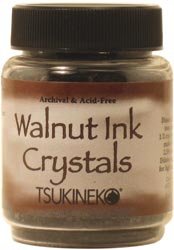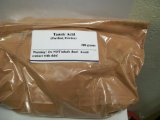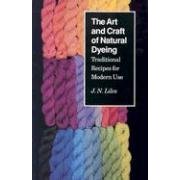How can I fix walnut dye to tone down the bright colors of Procion-dyed fabrics?
Name: Diane
—ADVERTISEMENTS—

Walnut Ink Crystals by Tsukineko

Purified Tannic Acid Powder

The Art and Craft
of Natural Dyeing:
Traditional Recipes for Modern Use
by J.N. Liles
Country or region: Mexico
Message: Hi Paula - living in Mexico - your forum is a lifeline!! I am an experienced dyer but am having problems with Walnut ink crystals. Have no email address for the manufacturer. I want to "knock back" some very bright procion dyed pieces of fabric I have to use for patchwork - rather like the lovely tones of Indian dyed cloth. I soaked my fabric in walnut ink solution - got lovely knocked back colours but it just wasn't fixed! Do you please know what mordant to use? I gather from my research that alum doesn't work - rather limited here for chemicals but i do have alum. Have searched the web for hours - no luck. Very many thanks Diane in Mexico
If washfastness is your priority, I recommend that you learn how to make subtle tones with Procion dyes. We're certainly not limited to bright colors with Procion dyes, though I've many times seen natural dyes enthusiasts claim that we are. The secret is to mix opposite colors from the color wheel. Mix navy blue with orange, or red with green, to create neutral browns. There are thousands of different browns possible by using varying amounts of other colors, and all of them can be obtained by mixing Procion dyes. Try different proportions of each of the three primary colors, turquoise, magenta, and yellow, mixed together. Be sure to keep careful notes of how much you use, so you'll know what to do next time when you want a similar color. You can get achieve neutrals with smaller amounts of dye powder if you start with a dull navy color, such as Procion blue MX-2G or navy MX-3R, instead of the bright clear turquoise.
Alternatively, you can buy pre-mixed Procion dyes in various shades of browns and grays; try several to see which gives your favorite results. Dharma, ProChem, and the many retailers of Jacquard Products all carry several different suitable premixed brown and gray Procion dyes.
Once you have obtained the neutral brown colors you like, you can use them for overdyeing already-dyed pieces (try overdyeing several different clashing colors with the same neutral tone to make them harmonize), or you can mix them with your bright colors of dye to get subtler ones.
Do you know how your walnut ink was produced? I have recipes for dyeing with walnuts, but a prepared ink product could contain anything, maybe iron mordant or another additive, no telling what, and no telling how much you need to use. It will be very important to figure out how much of the walnut ink you should use for your amount of fabric. Note that the recipes for dyeing cotton fabric with walnuts are different from those for dyeing wool or silk. Mordanting is very different on cellulose fibers than on protein-based fibers. Walnuts are supposed to dye wool or silk pretty well even without mordanting, but cotton and other plant fibers require mordants.
For reference while dyeing with natural dyes, nothing can substitute for a thorough and reliable book of well-tested recipes. My favorite is J. N. Liles's essential book The Art and Craft of Natural Dyeing: Traditional Recipes for Modern Use , which contains vast amounts of information. (You can view portions of this book online via Google Books, at least in the US.) In it, he recommends premordanting cotton or linen fabric for walnut dyeing in three separate steps, first with alum, then with tannin, and next with alum again, before applying the walnut dye. He says that, unlike with other dyes, it is fine to use cheap alum or aluminum sulfate that is contaminated with iron; normally you don't want iron contamination in your alum because it will darken any color.
, which contains vast amounts of information. (You can view portions of this book online via Google Books, at least in the US.) In it, he recommends premordanting cotton or linen fabric for walnut dyeing in three separate steps, first with alum, then with tannin, and next with alum again, before applying the walnut dye. He says that, unlike with other dyes, it is fine to use cheap alum or aluminum sulfate that is contaminated with iron; normally you don't want iron contamination in your alum because it will darken any color.
Liles's Basic Alum Recipe 2, on pages 20-21, looks like it should be a good choice for you: he says to dissolve one pound of aluminum sulfate in 2 quarts of hot water and allow to cool. Meanwhile, dissolve 1.5 ounces of washing soda in one pint of water, then add it slowly while stirring to the alum solution. Make a paste of half an ounce of chalk and add slowly while stirring, then add sufficient water to cover the material, about three to four gallons, and soak the fabric in it overnight.
After rinsing, proceed to the next step, mordanting with tannin, which Liles describes on page 19. Dissolve 1.5 ounces of tannic acid in five gallons of hot water in a nonreactive container and soak the fabric overnight, then repeat the alum mordanting as above. Rinse well after the last alum mordanting step, and proceed to the dyeing step. If you don't have access to tannic acid, you could substitute a much larger quantity of sumac, oak galls, or pomegranate rinds, all of which contain a considerable quantity of tannins.
Liles's recipe for dyeing cotton or linen with walnut is given on pages 177-8; unfortunately, unlike pages 19 and 20, this section is not included in the Google Books excerpt, at least as far as I can access, so you'll have to buy the book to see it. For one pound of cotton fabric, he calls for two gallons of green walnut rinds, or one and a half gallons of dry rinds, or four to five gallons of walnuts. I wonder how many jars of your walnut ink crystals will be required to equal this quantity! The method he gives involves soaking the walnuts overnight and then boiling them or simmering them for two hours. (That's been done already for your walnut ink crystals.) Once the walnut dyebath has been prepared, he says to start by adding the cotton or linen to the dyebath at room temperature, then heat it to between 170°F and 212°F and hold it at that temperature for two hours before removing, rinsing, and washing with detergent. Each of these many steps calls for mixing the fabric in carefully with the mordant bath or dyebath and working it around to make sure that all of the material is thoroughly soaked, while wearing good waterproof gloves.
Although walnut is a good dye, its washfastness will never equal that of a properly fixed synthetic fiber reactive dye, such as the Procion MX dyes. It would probably be best to use walnut to dye portions of a quilt that will be washed repeatedly only if you will be using it for the other fabrics in the quilt, as well. It's interesting to think of your patchwork's getting brighter and brighter with each washing, as the Procion dye outlasts the walnut, instead of getting more faded in color.
(Please help support this web site. Thank you.)
(Please help support this web site. Thank you.)
Posted: Sunday - September 09, 2012 at 10:20 AM
Follow this blog on twitter here.
Quick Links
- All About Dyes & Dyeing Top -
- Top of this blog -
- FAQ -
- The Dye Forum -
- How to Tie Dye - How to Batik -
- Books - Toys - Plants -
- Top of this blog -
- FAQ -
- The Dye Forum -
- How to Tie Dye - How to Batik -
- Books - Toys - Plants -
More in this category:
- -
Statistics
Total entries in this blog:
Total entries in this category:
Published On: Sep 09, 2012 11:23 AM
Total entries in this category:
Published On: Sep 09, 2012 11:23 AM
